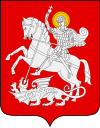Elections in Georgia (country)
Elections in Georgia gives information on elections and election results in Georgia. An election is a process in which a vote is held to elect candidates to an office. It is the mechanism by which a democracy fills elective offices in the legislature, and sometimes the executive and judiciary, and in which electorates choose local government officials.
 |
|---|
| This article is part of a series on the politics and government of Georgia |
|
Executive |
|
Legislature
|
|
Judiciary |
|
Administrative divisions
|
|
|
|
|
Related topics
|
|
|
Georgia elects on national level a head of state - the president - and a legislature. The president is elected for a five-year term by the people. The Parliament of Georgia has 150 members, elected for a four-year term, 77 seats by proportional representation and 73 in single-seat constituencies.
In the summer of 2019, protests in Georgia demanded a change to a more proportional system (removing the single-seat constituencies) and secured a promise from Georgian Dream party leader Bidzina Ivanishvili to do so. In November 2019, however, individual members of parliament voted against a bill to change the electoral system, sparking renewed protests.[1]
Statistics
Since 1990, there have been 22 elections conducted in Georgia, of which five have been Presidential, seven have been Parliamentary, seven have been Supreme Council of Adjara, and four have been local; there has also been onr referendum and one plebiscite. The greatest recorded number of voters (3,594,810) participated in the presidential elections held on May 26, 1991; on this same occasion, the highest turnout was also recorded, at 2,978,247. The largest number of observers (1848 international and 13,195 local organisations) was registered by the CEC for Parliamentary Elections on May 21, 2008.[2]
First multiparty elections
The very first independent multiparty elections in Georgia were held on October 28, 1990. Still the Soviet Republic, Georgia was firmly on its way to independence. The Soviet dictate, with its harsh rule, was about to end, illustrated by the first time multiparty elections were conducted. 14 political parties registered for these elections, which was held with a mixed system. The Supreme Council elected 250 (125 proportional, 125 majoritarian) MPs for five years. The total number of voters was 3444 thousand, 67% participated in this elections. Only four parties crossed the threshold and only two parties received mandates under the proportional system:
- "Round Table-Free Georgia" (81 MPs)
- The Communist Party of Georgia (44 MPs)
- In the majoritarian system the places were distributed as follows:
- "Round Table-Free Georgia" (43 MPs)
- Competition (17 MPs)
- People's Front (11 MPs)
- "Democratic Georgia" (2 MPs)
- Rustaveli Society (1 MP)
As a result of the advice, "Round Table - Free Georgia" came to power. Electoral commissions of political unions, public associations and organizations, labor collectives, secondary special and higher education institutions of citizens of the Republic of Georgia contributed to the elections. The rest of the rules of holding the parliamentary elections were determined by the law of the Republic of Georgia.
First Presidential Elections
On April 14, 1991, the presidential regime was introduced into Georgia. The Elections were deemed to be conducted in case of participation of majority of total number of voters. Candidates whom were supported by more than 50% of the total number of voters were deemed elected. Six candidates participated in these elections:[2]
1. Zviad Gamsakhurdia - 2,565,362 votes. 2. Valerian Advadze - 240,243 votes. 3. Jemal Mikeladze - 51,717 votes. 4. Nodar Natadze - 36,266 votes. 5. Irakli Shengelia - 26,886 votes. 6. Tamaz Kvachantiradze - 8,553 votes. Zviad Gamsakhurdia became the first president of independent Georgia. The total number of voters was recorded at 3,594,810. The number of voters who participated in the elections was recorded at 2,978,247.
Second Presidential Elections
The Elections were deemed to be held in case of the participation of the majority of total number of voters. The candidate supported by more than 50% of voters was deemed elected. Six candidates participated in these elections:[2]
1. Eduard Shevardnadze - 1,589,909 votes. 2. Jumber Patiashvili - 414,303 votes. 3. Akaki Bakradze - receiving 3,350 votes. 4. Panteleimon Giorgadze - 10,697 votes. 5. Kartlos Gharibashvili - 10,023 votes. 6. Roin Liparteliani - 7,948 votes. Eduard Shevardnadze became the second President of Georgia, receiving 77% of total votes. Total number of voters: 3,106,557. Number of voters participated in the elections: 2,139,369
Third Presidential Elections
The Elections were deemed held in case of participation of the majority of total number of voters. The candidate supported by more than 50% of voters would be deemed elected. Six candidates participated in the elections:[2]
1. Eduard Shevardnadze - 1,870,311 votes. 2. Jumber Patiashvili - 390,486 votes. 3. Kartlos Gharibashvili - 7,863 votes. 4. Avtandil Jogladze - receiving 5,942 votes. 5. Vazha Jghenti - 3,363 votes. 6. Tengiz Asanidze - 2,793 votes Eduard Shevardnadze retained the seat of the President of Georgia Total number of voters: 3,088,925. Number of voters participated in these elections: 2,343,176.
Latest elections
2012 Parliamentary election
Template:Georgian parliamentary election
2008 Presidential election
Template:Georgian presidential election
Past results
2008 Parliamentary election
Template:Georgian legislative election
2004 Presidential election
Template:Georgian presidential election
See also
- Elections in Abkhazia
- Elections in South Ossetia
- Electoral calendar
- Electoral system
References
- Nikoladze, Tatia (16 December 2019). "Why the proportional electoral system is so important for Georgia". Jam News.
- "Georgia - History of Elections" (PDF). infocenter.gov.ge. Government of Georgia. 2017.

